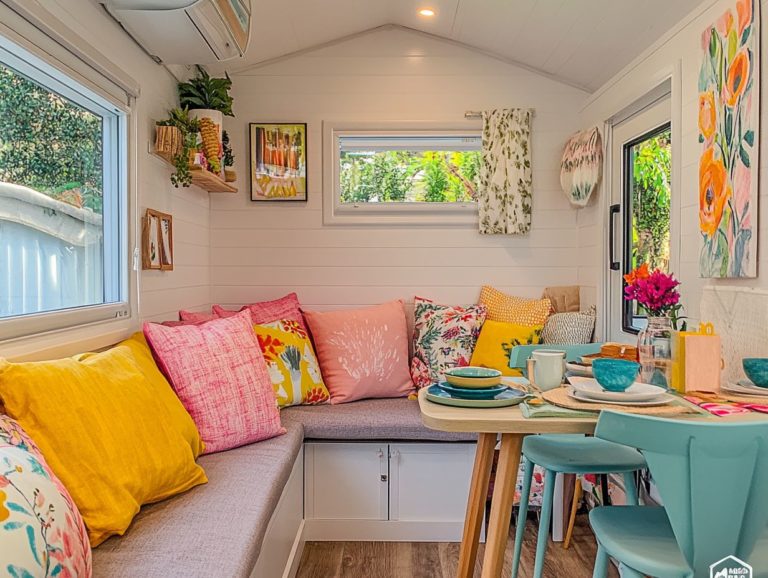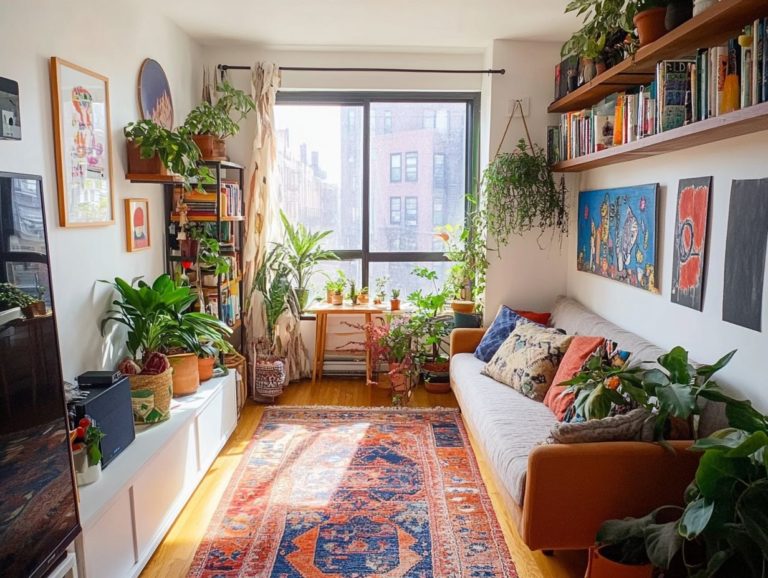Using Color Psychology in Tiny House Decor
Color is more than just visual appeal. It shapes our emotions and behaviors.
Explore color psychology. It can transform your tiny home into a vibrant and inviting space.
You will gain insight into the emotional effects of different colors and practical tips on selecting palettes for various rooms. This is aimed at making your space feel more expansive and cohesive.
Discover ways to express your unique personality through color. Ensure your tiny home genuinely reflects who you are.
Get ready to unlock the amazing power of color!
Contents
- Key Takeaways:
- How Color Affects Our Mood and Behavior
- Incorporating Color Psychology in Tiny House Decor
- Using Color to Create Illusions of Space
- Combining Colors for a Cohesive Look
- Personalizing Your Tiny House with Color
- Frequently Asked Questions
- What is color psychology and how does it relate to decor in tiny houses?
- What are some common colors used in tiny house decor and their corresponding psychological effects?
- How can I use color psychology to maximize the space in my tiny house?
- Are there any colors that should be avoided in tiny house decor?
- Can color psychology be used with other design elements in a tiny house?
- How can I add pops of color without overwhelming the space?
Key Takeaways:

- Understanding the emotional impact of colors helps create a desired mood in your tiny home decor.
- Strategic use of color can make a small space feel larger; for example, use light, cool tones and natural light.
- Select colors that reflect your unique personality to personalize your tiny house.
What is Color Psychology?
Color psychology is how different colors affect our emotions and choices. It delves into the intriguing interplay between colors and human emotions, blending art with science.
This captivating field has its roots in ancient civilizations, where colors carried significant meanings. Visionaries like Isaac Newton, who introduced the concept of the color wheel, and Johann Wolfgang von Goethe, who highlighted the emotional resonance of colors, shaped our understanding of how hues evoke feelings from tranquility to exhilaration.
Today, color psychology influences decisions in branding, advertising, and the creation of environments for both residential and commercial spaces. By harnessing color theory, designers craft moods and enhance visual appeal, transforming spaces into harmonious sanctuaries that resonate with human experiences.
How Color Affects Our Mood and Behavior
Grasping the impact of color on mood and behavior is essential. Each hue can trigger emotional responses that influence your thoughts and actions.
This is especially significant in tiny homes, where space is limited and every detail counts. Utilizing color to define spaces can enhance the overall feel of the home, as color psychology reveals that light shades can foster a serene atmosphere, while vibrant hues like red and orange can invigorate your environment.
Therefore, making intentional color choices is crucial for transforming your living space into an uplifting sanctuary.
Understanding the Emotional Impact of Colors
Colors affect our emotions in powerful ways. Each color has a specific meaning and can change how we feel, especially in the cozy confines of tiny homes. When decorating, it’s important to understand what to consider when decorating a tiny house.
For instance, blue and green evoke tranquility and connection to nature, while yellow and orange stir warmth and joy, enhancing the appeal of small spaces.
You can strategically incorporate these colors to cultivate a harmonious atmosphere that aligns with your emotional needs. Softer shades of blue in your bedroom promote relaxation, while vibrant oranges in the kitchen infuse energy and inspire social interactions.
Bringing in natural greens through indoor plants or decorative accents instills calm and connects your space to the outdoors, creating a refreshing and inviting environment. By understanding the psychological effects of color, you can design spaces that elevate your well-being and aesthetic pleasure.
Incorporating Color Psychology in Tiny House Decor

Incorporating color psychology into your tiny house decor is a brilliant way to elevate design possibilities in compact spaces. Understanding the impact of color on tiny house decorating enables you to select colors that reflect your personal style and enrich your living experience.
By implementing a cohesive color scheme that harmonizes neutral tones with striking hues, you can craft visually captivating and inviting environments. Use decorative elements to unify the design and enhance the atmosphere you wish to cultivate, transforming your small space into a haven of creativity and comfort.
Choosing Colors for Different Rooms
Selecting the right colors for various rooms profoundly influences the ambiance and functionality of your tiny home. Each area serves a unique purpose, requiring a tailored approach to color selection.
For example, calming shades like soft blues and greens in your bedroom foster relaxation. In contrast, vibrant hues such as yellow or red can invigorate spaces like your kitchen or home office, perfectly aligning with color psychology principles.
Understanding how color impacts mood can enhance your experience in every room. In the living room, warm tones like oranges and browns create an inviting atmosphere, ideal for family gatherings. A neutral palette accented with pops of color crafts an adaptable space that feels fresh and welcoming.
Using complementary colors introduces dimension, making your spaces feel either more expansive or cozier, depending on your design goals. By curating your color combinations thoughtfully, you can blend functionality with a visually appealing environment, ensuring each room looks good and feels good.
Using Color to Create Illusions of Space
Using color intentionally creates striking illusions of space, transforming small homes into expansive havens. This is vital for effective interior design in compact living areas.
Opt for light shades like whites and soft pastels to amplify natural light. A monochromatic palette fosters a cohesive visual flow. Together, these choices create a balanced and airy atmosphere that enhances your overall experience.
Tricks for Making a Tiny Space Feel Bigger
To make your tiny space feel more expansive, employ strategies like strategic color choices and decorative elements. Using light shades on walls and furnishings helps reflect light and creates an airy ambiance. Maintaining color balance ensures cohesion and warmth.
Incorporating mirrors can dramatically expand your space. They visually reflect light and your existing d cor, making the room feel larger than life.
Choosing multi-functional furniture that combines storage and aesthetics offers necessary practicality without sacrificing style. For example, a chic ottoman with hidden storage can keep clutter at bay and provide extra seating when needed.
Layered lighting from ambient to task lighting adds depth to your space. Use floor lamps and wall sconces to save valuable surface area.
By combining these elements thoughtfully, you can transform your tiny home into an expansive and inviting sanctuary.
Combining Colors for a Cohesive Look

Combining colors effectively is crucial for achieving a cohesive look in tiny home design, where space constraints make visual harmony essential. By exploring various color schemes like complementary colors and colors next to each other on the color wheel you can create interiors that reflect your personal style while adhering to color psychology principles.
This approach ensures every hue contributes to a serene and inviting atmosphere in your compact living space.
Don t wait! Start transforming your tiny home today with these exciting color strategies!
Color Schemes and Colors That Go Well Together
Color schemes can truly elevate the visual appeal of your tiny home. By pairing colors that sit opposite each other on the color wheel, you can create vibrant contrasts that invigorate your spaces. This draws attention to key features while maintaining a harmonious atmosphere.
For example, use a lively shade of orange with its complementary blue to transform your tiny home living room into a stunning focal point. Picture bright orange throw pillows accentuating a soothing blue couch.
Combining deep green with warm red adds depth and evokes a sense of coziness, making any small area feel inviting.
To successfully integrate these color schemes, consider smaller accents like artwork, rugs, or plants that provide bursts of complementary hues. Thoughtfully selected accessories can make even your tiniest areas feel layered and dynamic, showcasing a rich visual narrative that reflects your personal style.
Personalizing Your Tiny House with Color
Personalizing your tiny house with color is a remarkable opportunity to showcase your unique personality and style. This transforms the space into a true reflection of who you are. By choosing colors that evoke emotions and align with your lifestyle, you can craft a warm and inviting environment that feels distinctly yours.
Each corner of your home becomes a personal sanctuary, radiating comfort and individuality.
Using Color to Reflect Your Personality
Using color to reflect your personality in a tiny home is a captivating way to showcase your individuality. By incorporating hues that resonate with your character, such as warm tones for a welcoming atmosphere or vibrant shades for an energetic vibe, you transform your tiny home into a true expression of who you are.
If you identify with calmness, soothing blues and greens can create a serene environment. Those with a bold spirit may enjoy fiery reds or deep purples, infusing their living space with dynamic energy.
Choosing colors that mirror your identity personalizes your home and influences the mood within it. A thoughtfully curated color palette wraps you in comfort or ignites your creativity and productivity.
Subtle shifts in color can profoundly affect your daily life, enhancing positivity and comfort in compact living spaces.
Frequently Asked Questions

What is color psychology and how does it relate to decor in tiny houses?
Color psychology is how colors influence our emotions, moods, and behavior. In tiny house decor, understanding the best color schemes can create a certain atmosphere or evoke specific feelings.
What are some common colors used in tiny house decor and their corresponding psychological effects?
- Neutral colors like white, beige, and grey create a sense of calm and spaciousness.
- Bold colors like red, yellow, and orange add energy and warmth.
- Cool colors like blue and green promote relaxation and tranquility.
How can I use color psychology to maximize the space in my tiny house?
Use lighter colors like white or pastel shades to make the space appear larger. You can also apply color blocking techniques to create visual boundaries and define different areas.
Are there any colors that should be avoided in tiny house decor?
Avoid dark colors in small spaces, as they can make the area feel even smaller. Consider the amount of natural light, as certain colors may appear different in natural vs. artificial light.
Start exploring colors that resonate with you today!
Can color psychology be used with other design elements in a tiny house?
Absolutely! Color psychology is perfect for creating a cozy space when combined with lighting, furniture placement, and textures.
These elements work together to make your tiny house feel inviting and harmonious.
How can I add pops of color without overwhelming the space?
One effective way is to use small accent pieces like pillows, rugs, and wall art.
Choose one bold color as a statement piece and keep the rest neutral to maintain balance.






